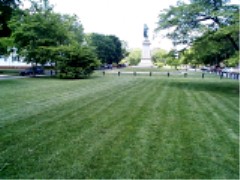|
Knowledgeable Staff - Quality Products |
|
||
|
|
|
|
||
|
|
|
|
|
Knowledgeable Staff - Quality Products |
|
||
|
|
|
|
||
|
|
|
|
 LAWN
CARE TIPS LAWN
CARE TIPS |
|
|
SOME BASIC KEYS TO SUCCESSFULLY GROWING A LAWN
SPRING:
Weed control from March through June with pre- emergent crabgrass control beginning in March and post emergent selective broadleaf weed control as needed through the growing season.
FALL:
Seeding & Aeration. September through early October are the best times to seed your lawn for full root development prior to adverse summer conditions. Fall aeration loosens compacted soil. Well planned fall weed control is also worthwhile.
LIMING:
Surface Applications. Apply 30 to 40 pounds of lime per 1,000 square feet per season (Spring or Fall). Better yet, test your soil's pH.
FERTILIZATION SCHEDULE:
Use a good quality, slow release fertilizer such as our Greenskeeper 10-6-4. A full feeding of any turf fertilizer is one pound of nitrogen applied to 1,000 square feet.
SCHEDULE:
Early September - Full
feeding
Thanksgiving - Full
feeding
April (at appropriate
point) - Half feeding of fertilizer. Apply after spring growth or
"flush" has slowed down.
EXAMPLE: Full Feeding: 50 pounds of Greenskeeper 10-6-4 fully feeds 5,000 square feet (1 pound of nitrogen per 1,000 square feet.)
Half Feeding: 50 pounds of Greenskeeper 10-6-4per 10,000 square feet (1/2 pound of nitrogen per 1,000 square feet).
WHAT KIND OF SEED SHOULD I USE?
Warm season (Southern) grasses consist of Zoysia grass, Bermuda grass, Centipede grass and St. Augustine grass. Zoysia and Bermuda are winter hardy varieties for this region. These grasses enter dormancy from October to May. They are invasive around flower beds.
Cool season (Northern) grasses consist of Tall Fescues, Ryegrasses, Fine Fescues and Bluegrasses. Bluegrasses and ryegrasses are less heat tolerant than Tall Fescues, but they do come in handy in some applications.
Tall Fescues are sun lovers with a good shade tolerance, such as Kentucky 31, Winning Colors, and Rebel. Hundreds of varieties of "Turf Type Tall Fescues" are available. Kentucky 31 is a forage grass, thus it is much coarser than turf types.
Fine Fescues are very handy for shady or low maintenance areas such as steep slopes. Creeping Red Fescue is good for dense shade.
We also offer a blend of grasses called Roxbury Lawn Grass, which is immensely popular for this region.
Quick Seed Guide
For New Lawns:
Roxbury Lawn Grass
65% Turf Type Tall
Fescue
20%
Perennial Ryegrass
10% Creeping Red Fescue
5% Kentucky Bluegrass
Over seeding for full
sun/partial shade:
Turf-Type Tall Fescue
Blends such as "Winning Colors Tall Fescue" or "Rebel Supreme Tall Fescue"
Dense shade under heavy
tree canopies:
Creeping Red (Fine)
Fescue (Does not tolerate heavy sun).
Heavy Traffic:
Perennial Ryegrass
(turf type) (Will need summer irrigation).